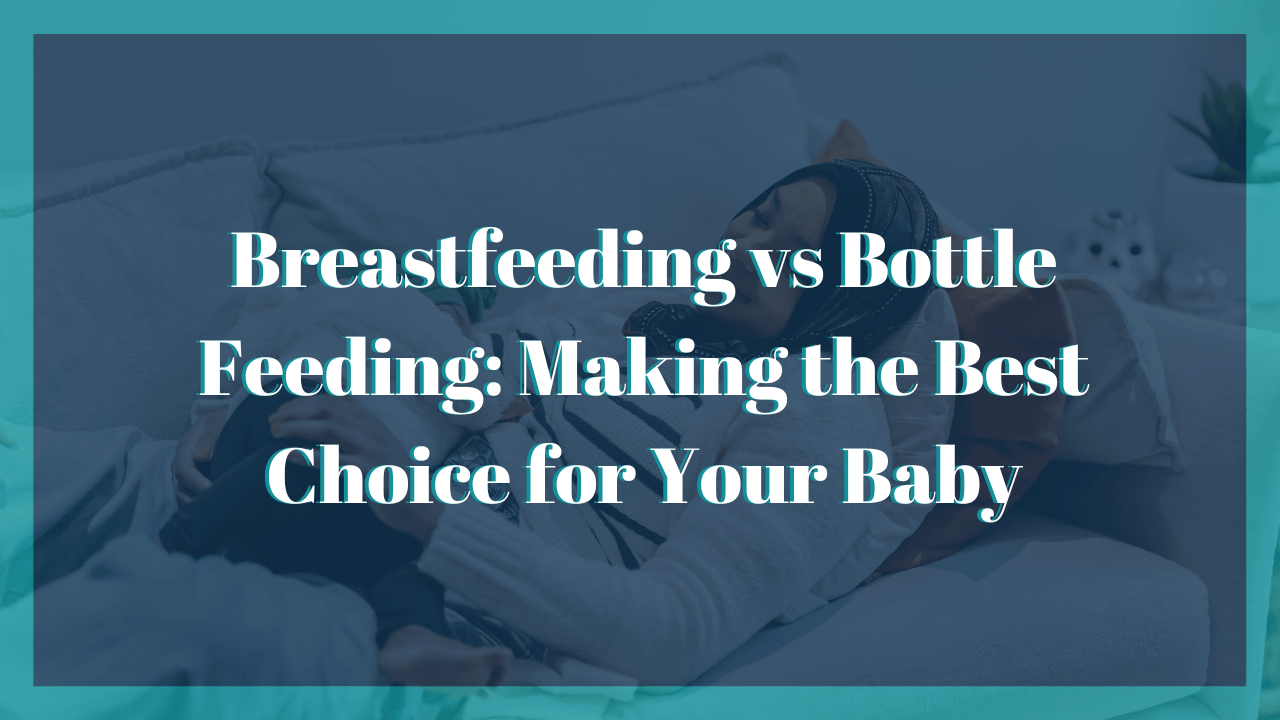Breastfeeding vs Bottle Feeding: Making the Best Choice for Your Baby in 2024
Choosing between breastfeeding vs bottle feeding is one of the first major decisions you’ll make as a new parent. This choice often comes with a mix of emotions, advice from well-meaning family members, and an overwhelming amount of information from healthcare professionals. But don’t worry—you’re not alone in this! Whether you’re drawn to breastfeeding for its natural bonding benefits or considering bottle feeding for its flexibility, this article is here to guide you. We’ll explore the benefits and challenges of each option, share expert insights, and help you make an informed decision that fits your baby’s needs and your family’s lifestyle. Remember, every family is unique, and there’s no one-size-fits-all solution when it comes to feeding your baby.
Understanding Breastfeeding: Benefits and Challenges

Breastfeeding is widely recognized for its nutritional and emotional benefits, but it also comes with practical challenges that parents should be aware of.
Nutritional Benefits of Breastfeeding
Breast milk is often described as the ideal nutrition for infants. It provides the exact nutrients your baby needs, including a balance of proteins, fats, carbohydrates, and vitamins, which are all crucial for your baby’s development. Breast milk also contains antibodies that help protect your baby from infections and illnesses, particularly in the early months. These antibodies can reduce the risk of respiratory infections, diarrhea, and ear infections. Additionally, the composition of breast milk adapts to meet your baby’s needs at different stages of growth, making it a dynamic source of nutrition that formula cannot replicate.
Emotional Bonding Through Breastfeeding
Breastfeeding fosters a close emotional bond between mother and baby, facilitated by physical closeness and skin-to-skin contact. This bonding experience is important for both emotional and physiological reasons. Breastfeeding triggers the release of oxytocin, often referred to as the “love hormone,” which helps strengthen the emotional connection between mother and child. Many mothers find that this bonding time is a special part of their daily routine, contributing positively to their overall well-being and the baby’s sense of security.
Health Benefits for Moms
Breastfeeding also offers health benefits for mothers. It can help with postpartum weight loss because it burns extra calories. Moreover, research suggests that breastfeeding can lower the risk of developing certain cancers, such as breast and ovarian cancer. It also promotes uterine contractions, which can help reduce postpartum bleeding and assist in the uterus returning to its pre-pregnancy size. These benefits contribute to the overall health and recovery of the mother after childbirth.
Practical Challenges of Breastfeeding
While breastfeeding offers many benefits, it can also present challenges, particularly for new mothers. One common issue is difficulty with the baby’s latch, which can cause nipple pain and reduce milk intake. Proper latch techniques can help mitigate these issues, but they often require practice and, in some cases, professional guidance from a lactation consultant. Additionally, breastfeeding requires frequent feedings, especially in the first few months, which can be physically and emotionally demanding. This can lead to fatigue and stress, making it important for mothers to have a support system in place.
Social and Cultural Considerations
The decision to breastfeed can be influenced by social and cultural factors. In some cultures, breastfeeding is strongly encouraged and supported, while in others, it may not be as common or may even be discouraged in public. Additionally, access to breastfeeding support, such as lactation consultants and breastfeeding-friendly environments, can vary. Understanding these social and cultural dynamics is important for mothers as they navigate their breastfeeding journey, helping them find the support and resources they need.
Exploring Bottle Feeding: Advantages and Drawbacks

Bottle feeding is a common choice for many families, whether it’s through formula feeding or expressed breast milk. This method offers a range of advantages, but it also comes with potential drawbacks. Understanding these aspects can help you make an informed decision that aligns with your family’s needs.
Convenience and Flexibility of Bottle Feeding
One of the main advantages of bottle feeding is the convenience and flexibility it offers. Unlike breastfeeding, which typically requires the mother to be present, bottle feeding allows other caregivers to participate in feeding the baby. This can be particularly beneficial for working parents or in situations where the mother needs to be away from the baby for extended periods. The ability to feed the baby at any time without being physically present provides a significant level of freedom. Additionally, bottle feeding allows parents to easily monitor and measure the exact amount of milk or formula the baby consumes, which can be reassuring for those concerned about their baby’s intake.
Nutritional Considerations with Formula Feeding
When it comes to nutrition, formula feeding offers a consistent and reliable alternative to breast milk. Modern infant formulas are designed to closely mimic the nutritional composition of breast milk, providing essential nutrients like proteins, fats, vitamins, and minerals. For babies who are unable to breastfeed due to medical reasons or maternal choice, formula feeding ensures they receive adequate nutrition to support healthy growth and development. There are also specialized formulas available for babies with specific dietary needs, such as hypoallergenic formulas for those with cow’s milk protein allergies. While the formula does not contain the natural antibodies found in breast milk, it is rigorously tested and regulated to ensure safety and nutritional adequacy.
Bonding Opportunities for All Caregivers
Bottle feeding can also enhance bonding opportunities between the baby and other family members. Since anyone can bottle-feed the baby, it allows fathers, grandparents, and other caregivers to share in the feeding experience, fostering a close relationship with the baby. This shared responsibility can help alleviate the physical and emotional demands on the mother, promoting a more balanced caregiving dynamic within the family. The act of feeding, whether through breast or bottle, is inherently nurturing, and bottle feeding can still provide a comforting, bonding experience for the baby.
Cost and Accessibility of Bottle Feeding
While bottle feeding offers flexibility, it also comes with costs that should be considered. Formula can be expensive, especially over the long term, and prices can vary depending on the brand and type of formula chosen. Additionally, bottle feeding requires the purchase of bottles, nipples, and sterilization equipment, all of which add to the overall expense. For families on a tight budget, the cost of formula and supplies can be a significant factor in the decision-making process. It’s also important to consider the accessibility of the formula, as families in certain regions or with specific dietary preferences may find it challenging to obtain the right formula consistently.
Potential Health Impacts of Bottle Feeding
Another aspect to consider is the potential health impacts of bottle feeding. While the formula is nutritionally adequate, it does not contain the natural antibodies and immune-boosting properties found in breast milk. This means that formula-fed babies may have a slightly higher risk of certain infections and illnesses, particularly in the first year of life. However, with proper hygiene practices, such as sterilizing bottles and preparing formulas correctly, these risks can be minimized. It’s also important for parents to choose a formula that suits their baby’s needs, as some infants may be sensitive to certain ingredients, leading to digestive issues or allergies. Consulting with a pediatrician can help parents make an informed choice and address any health concerns.
Combining Breastfeeding and Bottle Feeding: Finding a Balance

Many parents choose to combine breastfeeding and bottle feeding to take advantage of the benefits of both methods. This approach, often referred to as mixed feeding, can offer flexibility while ensuring that your baby still receives the nutritional and bonding benefits of breastfeeding. However, it requires careful planning and consideration to maintain a balance that works for both the baby and the mother.
Introducing Bottle Feeding to a Breastfed Baby
Introducing bottle feeding to a breastfed baby can be a delicate process. One common concern is the risk of nipple confusion, which occurs when a baby has difficulty switching between the breast and bottle due to differences in sucking techniques. To minimize this risk, it’s recommended to wait until breastfeeding is well-established, typically after the first four to six weeks, before introducing a bottle. When you do introduce a bottle, consider using a slow-flow nipple that mimics the flow of breast milk to help your baby transition more smoothly. Offering the bottle when the baby is calm and not overly hungry can also improve acceptance. Gradually introducing bottle feeding allows the baby to adjust without disrupting the breastfeeding routine.
Maintaining Milk Supply While Bottle Feeding
One of the key challenges in combining breastfeeding and bottle feeding is maintaining a sufficient milk supply. Breast milk production is based on supply and demand; the more frequently your baby nurses, the more milk your body will produce. When bottle feeding is introduced, especially if formula is used, there may be a reduction in the frequency of breastfeeding sessions, which can lead to a decrease in milk supply. To maintain your supply, it’s important to continue breastfeeding or pumping regularly. Some mothers choose to pump breast milk to ensure their baby continues to receive it even when bottle feeding. Pumping at times when the baby would normally nurse, such as during work hours or when introducing a bottle, can help sustain milk production.
Pumping and Storing Breast Milk
Pumping breast milk can be a valuable tool for mothers who are combining breastfeeding and bottle feeding. It allows you to continue providing breast milk when you’re away from your baby or when someone else is feeding them. To effectively pump, it’s important to use a high-quality breast pump that is comfortable and efficient. Once you’ve pumped, proper storage of breast milk is crucial to ensure its safety and nutritional value. Breast milk can be stored in the refrigerator for up to four days or in the freezer for up to six months. Always label the milk with the date it was expressed, and follow guidelines for thawing and warming breast milk safely before feeding.
Establishing a Feeding Routine
Creating a feeding routine that incorporates both breastfeeding and bottle feeding can help ensure consistency and predictability for both you and your baby. Some parents choose to breastfeed during certain times of the day, such as mornings and evenings, while using bottle feeding during other times, such as when at work or during nighttime feedings. Establishing a routine can help your baby adapt to the different feeding methods and provide structure to your day. It’s important to remain flexible, as your baby’s needs may change over time, and adjustments to the routine may be necessary.
Addressing Common Concerns with Mixed Feeding
Mixed feeding can raise several concerns, such as whether the baby will develop a preference for the bottle over the breast or if the balance between breast milk and formula is adequate. Some babies may prefer the faster flow of a bottle, leading to challenges in continuing breastfeeding. If this occurs, consider offering the breast first during feedings to encourage continued breastfeeding. Another concern is ensuring that the baby is getting enough breast milk while supplementing with formula. Monitoring the baby’s weight gain, growth, and overall satisfaction can help reassure you that they are receiving the right balance of nutrients. Regular check-ups with a pediatrician can also provide guidance and support.
Making the Decision: What’s Best for Your Baby and Family

Deciding how to feed your baby is one of the most important choices you’ll make as a new parent. Whether you choose breastfeeding, bottle feeding, or a combination of both, it’s essential to consider what’s best for your baby’s health and what aligns with your family’s lifestyle and values. This decision is deeply personal and can be influenced by various factors, including health considerations, family dynamics, and access to support and resources.
Evaluating Your Baby’s Nutritional Needs
The first and foremost consideration in making this decision is your baby’s nutritional needs. Breastfeeding is often recommended as the best option for the first six months because of the unique benefits it offers, such as providing antibodies that protect against infections and promoting healthy weight gain. However, formula feeding also provides essential nutrients and can be a suitable alternative or supplement, especially if breastfeeding is not possible due to medical conditions or other challenges. Consulting with your pediatrician can help you understand what will best meet your baby’s nutritional needs based on their health and development.
Considering Your Health and Well-being
Your own health and well-being are critical factors in this decision as well. Breastfeeding can be demanding, both physically and emotionally. Conditions such as mastitis, low milk supply, or postpartum depression can make exclusive breastfeeding challenging. In such cases, incorporating bottle feeding or exclusively using formula might be necessary to ensure that you’re able to care for yourself while meeting your baby’s needs. It’s important to remember that a healthy, well-supported mother is essential for the baby’s well-being. Balancing your health with your baby’s nutritional needs is key to making the best choice for your family.
Assessing Family Dynamics and Support Systems
The dynamics of your family and the level of support you have can greatly influence your feeding decision. If you have a strong support system, such as a partner who can help with bottle feeding or family members who can assist with caregiving, you may find it easier to incorporate bottle feeding or combine it with breastfeeding. On the other hand, if you are a single parent or have limited help, exclusive breastfeeding might feel more manageable or, conversely, more challenging. The availability of resources like lactation consultants, breastfeeding support groups, or formula options can also play a role in your decision-making process. Having a clear understanding of the support available to you can help you make a more informed choice.
Balancing Work and Feeding Choices
For working parents, the decision often involves finding a balance between feeding and work commitments. If you plan to return to work, you may need to consider how bottle feeding or pumping breast milk can fit into your routine. Many workplaces offer lactation rooms and support for breastfeeding mothers, but if your job doesn’t accommodate pumping, formula feeding or mixed feeding might be more practical. Planning ahead and discussing your needs with your employer can help ensure that your feeding choice aligns with your work life, allowing you to provide for your baby while fulfilling your professional responsibilities.
Addressing Personal Values and Beliefs
Your personal values, cultural beliefs, and parenting philosophy also play a significant role in making this decision. Some parents feel strongly about breastfeeding due to its natural benefits and the emotional bond it fosters, while others may prioritize the flexibility and shared responsibility that bottle feeding offers. Cultural norms and family traditions may also influence your choice, either by encouraging breastfeeding or supporting formula feeding. Reflecting on what feels right for you and your family, while also considering practicalities, can guide you toward a decision that aligns with your values.
Navigating Social Pressures and Expectations
It’s important to acknowledge that social pressures and expectations can impact your decision-making process. New parents often face opinions and advice from family, friends, and even strangers about the “best” way to feed their baby. While these perspectives can be helpful, they can also create added stress or guilt. It’s crucial to remember that there is no one-size-fits-all approach to feeding your baby. The best decision is the one that works for you and your family, meets your baby’s nutritional needs, and feels sustainable in the long term. Trusting your instincts and seeking advice from trusted healthcare professionals can help you navigate these pressures.
Finalizing Your Feeding Plan
Once you’ve considered all these factors—your baby’s needs, your health, family dynamics, work commitments, personal values, and social pressures—you can begin to finalize a feeding plan that works for your family. Keep in mind that this plan may evolve over time as your baby grows and your circumstances change. Flexibility is key; what works in the early weeks might need adjustment later on. Ultimately, the goal is to ensure that your baby is well-fed, healthy, and thriving, while also maintaining your own well-being. Whatever decision you make, it’s important to feel confident that you’re doing what’s best for your baby and family.
Conclusion:Breastfeeding Vs Bottle Feeding
Deciding between breastfeeding vs bottle feeding is a deeply personal decision that depends on many factors, including your baby’s needs, your health, and your family’s lifestyle. By considering the benefits and challenges of each option, you can make an informed choice that supports your baby’s growth and development while also fitting into your family’s routine. Whether you choose breastfeeding, bottle feeding, or a combination of both, the most important thing is that your baby is healthy, happy, and well-nourished. Trust your instincts, seek support when needed, and remember that the right choice is the one that works best for you and your family.







